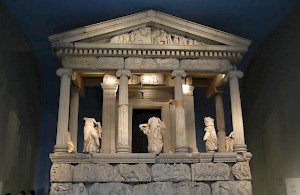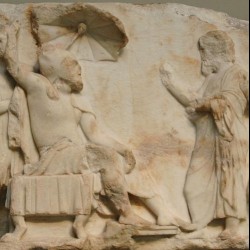Xanthus, Nereid Monument
Q890386Xanthus: town in western Lycia; its original name was Arňna, its modern name is Kınık.
Nereid Monument

The most famous Lycian tomb from Xanthus is the Nereid Monument, which is now in the British Museum. Built in the first quarter of the fourth century BCE, it offers a combination of Greek and oriental motifs. It seems to have been the tomb of a Lycian prince named Arbinas and may have inspired the better-known Mausoleum of Halicarnassus, the tomb of Maussolus, the famous satrap of Caria.
The Nereid Monument consists of a podium and a building that resembles a Greek temple in Ionic style. Between the columns are three statues that have been identified with the Nereids (water goddesses) from which the monument takes its name.

It is the sculpture surrounding the base that makes it special. We see, for example, soldiers, in a phalanx. They may be Greek mercenaries, because their arms are those of a hoplite. Note (on the second photo below) the helmet of the man to the left, which ought to cover his face, but in fact leaves it visible. Obviously, the artist wanted to show the soldier's face, and it is possible that this is a portrait. As so often, we do not know.
Another relief (third photo below) shows a Persian official, probably a satrap, receiving an embassy. A young servant shades his master with a parasol, an attribute that is also known from Persepolis, where it is a sign of royalty.
There's also a banquet scene, possibly the festivities after the war. The reclining man drinks from both a flat cup and a rhyton: the first one is Greek, the second one is Persian. Whoever the artist was, he regarded Greece and Persia as compatible.



